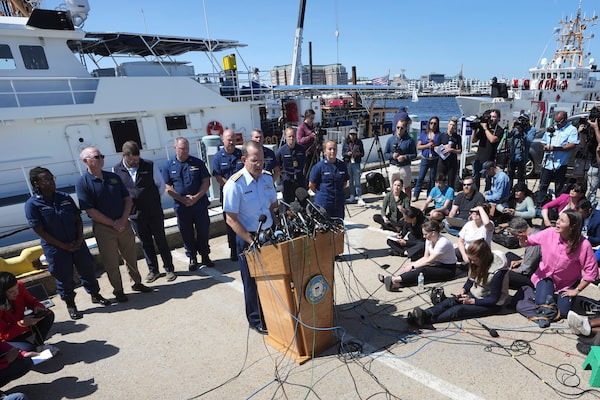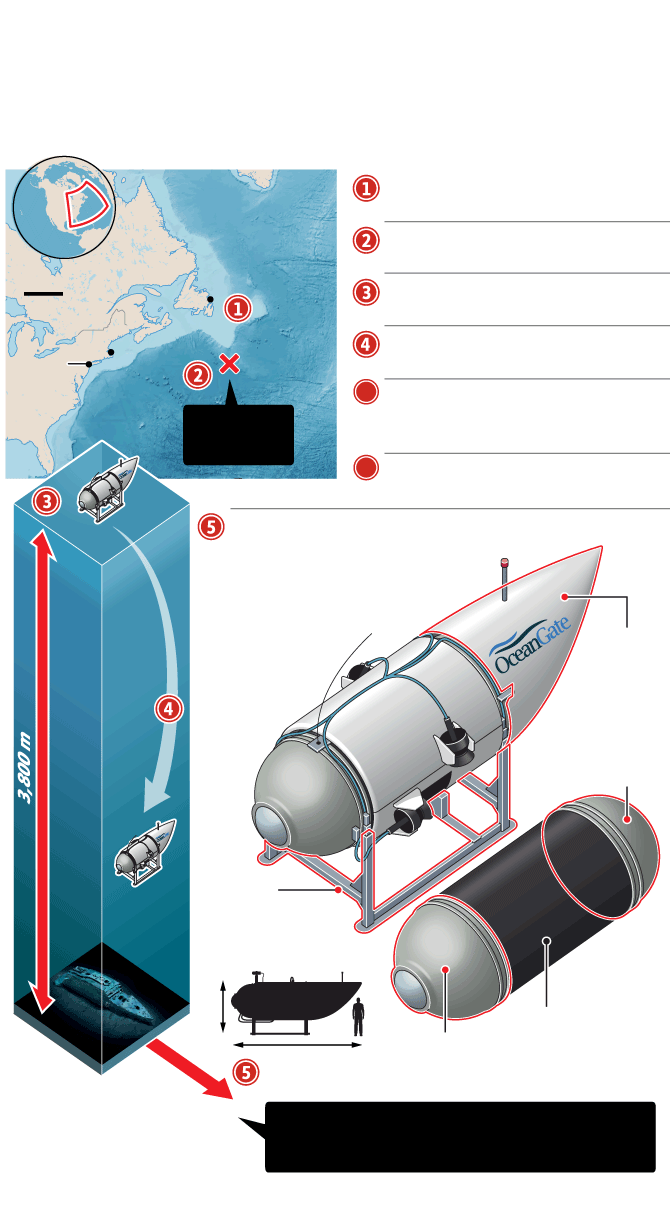
U.S. Coast Guard updates the media on June 22, 2023Steven Senne/The Associated Press
Authorities in Canada and the United States have launched separate investigations into the Titan submersible disaster, a maritime drama that culminated this week when the U.S. Coast Guard determined the vessel had suffered a “catastrophic implosion” that killed all passengers.
The Transportation Safety Board of Canada said on Friday that it will look into both the Titan, a privately owned and operated submersible, and the Polar Prince, its Canadian-flagged support ship. TSB’s counterpart in the United States, the National Transportation Safety Board, said it will participate in an investigation led by the U.S. Coast Guard.
The Titan, which was about 6.5 metres long, was reported missing Sunday with five people aboard. The vessel was on a mission to explore the wreckage of the Titanic, about four kilometres below the ocean’s surface. It lost contact with the Polar Prince about one hour and 45 minutes into its dive, setting off a multinational search effort. It was estimated that, if still alive, the group would have 96 hours of oxygen available.
On Thursday, OceanGate Expeditions, the company leading the Titan voyage, said the five adventurers were dead. A crew guiding a remotely operated vehicle spotted pieces of the submersible about 500 metres from the bow of the Titanic.
OceanGate is a U.S. company but the voyage started in a Canadian harbour before it turned fatal in international waters. Experts said this could create a number of legal tangles, while also giving way for multiple agencies to rightfully claim jurisdiction.
Canada’s TSB said it is sending a team to St. John’s and would work with other agencies. Citing the Canadian Transportation Accident Investigation and Safety Board Act and unnamed international agreements, the board said it is the “investigation authority of the flag state of the support vessel” and will therefore execute “a safety investigation regarding the circumstances of this operation conducted by the Canadian-flagged vessel Polar Prince.”
While TSB investigations can take years to complete, the board can’t assign fault or determine civil or criminal liability.
The Polar Prince, a former Canadian Coast Guard vessel, is owned by the Miawpukek First Nation in southern Newfoundland. There were 17 crew members and 24 people on board the Polar Prince, the TSB said. Five of those passengers were subsequently on the Titan.
Peter Knudson, a spokesman for the National Transportation Safety Board in the United States, confirmed American agencies will also investigate.
“The U.S. Coast Guard has declared the loss of the Titan submersible to be a major marine casualty; they will lead the investigation,” he said in a statement. “The NTSB has joined the investigation and will contribute to their efforts.”
He directed media inquiries to the USCG. The Northeast division of the USCG did not return messages seeking comment.
OceanGate, through a spokesman, declined to comment.
Jeff Heaton, the operations manager and chief submersible pilot at North Vancouver’s Nuytco Research Ltd., said the catastrophic implosion must have happened when the Titan was descending because it takes longer than one hour and 45 minutes to reach the ocean floor at the Titanic site.

Titan destroyed in “catastrophic implosion”
A deep-sea submersible carrying five people on a voyage to
the Titanic wreck suffered a “catastrophic implosion” that
killed everyone aboard, U.S. Coast Guard officials say.
June 16: Canadian research
vessel MV Polar Prince sets sail
ATLANTIC
OCEAN
June 18: Ship arrives
near Titanic site
CANADA
St. John’s
500 km
08:00 local time: Submersible
starts dive to Titanic wreck
09:45: Polar Prince loses
contact with Titan
Boston
New
York
U.S. Navy detects sounds
“consistent with implosion"
shortly after loss of contact
U.S.
Wreck of
Titanic
17.40: U.S. Coast Guard alerted –
search and rescue mission begins
June 22: Robotic diving vehicle
finds debris field from Titan on
seabed near Titanic wreck
PARTS FOUND
ON SEA FLOOR
Tail
cone
Aft end
cap
Landing
frame
Pressure
hull
TITAN
2.8 m
Cylinder:
12.7-cm-thick
carbon-fibre
Bow
end cap
6.7 m
Objects
not to scale
Titan debris lies around 490 metres
from bow of Titanic at depth of 3,800 m
graphic news, Sources: OceanGate Expeditions; U.S. Coast Guard; BBC

Titan destroyed in “catastrophic implosion”
A deep-sea submersible carrying five people on a voyage to
the Titanic wreck suffered a “catastrophic implosion” that
killed everyone aboard, U.S. Coast Guard officials say.
June 16: Canadian research
vessel MV Polar Prince sets sail
ATLANTIC
OCEAN
June 18: Ship arrives
near Titanic site
CANADA
St. John’s
500 km
08:00 local time: Submersible
starts dive to Titanic wreck
09:45: Polar Prince loses
contact with Titan
Boston
New
York
U.S. Navy detects sounds
“consistent with implosion"
shortly after loss of contact
U.S.
Wreck of
Titanic
17.40: U.S. Coast Guard alerted –
search and rescue mission begins
June 22: Robotic diving vehicle
finds debris field from Titan on
seabed near Titanic wreck
PARTS FOUND
ON SEA FLOOR
Tail
cone
Aft end
cap
Landing
frame
Pressure
hull
TITAN
2.8 m
Cylinder:
12.7-cm-thick
carbon-fibre
Bow
end cap
6.7 m
Objects
not to scale
Titan debris lies around 490 metres
from bow of Titanic at depth of 3,800 m
graphic news, Sources: OceanGate Expeditions; U.S. Coast Guard; BBC

Titan destroyed in “catastrophic implosion”
A deep-sea submersible carrying five people on a voyage to the Titanic wreck suffered
a “catastrophic implosion” that killed everyone aboard, U.S. Coast Guard officials say.
June 16: Canadian research
vessel MV Polar Prince sets sail
ATLANTIC
OCEAN
June 18: Ship arrives
near Titanic site
CANADA
St. John’s
500 km
08:00 local time: Submersible
starts dive to Titanic wreck
09:45: Polar Prince loses
contact with Titan
Boston
New
York
U.S. Navy detects sounds
“consistent with implosion"
shortly after loss of contact
U.S.
Wreck of
Titanic
17.40: U.S. Coast Guard alerted –
search and rescue mission begins
June 22: Robotic diving vehicle
finds debris field from Titan on
seabed near Titanic wreck
PARTS FOUND
ON SEA FLOOR
Tail
cone
Aft end
cap
Landing
frame
Pressure
hull
TITAN
2.8 m
Cylinder:
12.7-cm-thick
carbon-fibre
Bow
end cap
6.7 m
Objects
not to scale
Titan debris lies around 490 metres
from bow of Titanic at depth of 3,800 m
graphic news, Sources: OceanGate Expeditions; U.S. Coast Guard; BBC
OceanGate’s cylindrical design and its use of carbon fibre worried Mr. Heaton and his colleagues in the submersible business.
“As an industry, we had expressed concerns years ago. Not only on the design but on their approach to testing,” he said.
A cylindrical design is not the best choice for vessels that will be exposed to external pressure, Mr. Heaton explained, because the long axis is very weak.
“This is the only deep-diving submersible hull that uses a cylinder,” he said. “All of the deep-diving submersibles use spheres,” because they are much stronger and able to distribute pressure equally.
The Titan’s carbon fibre hull also made OceanGate an outlier; other deep-diving vessels use titanium or high-strength steel alloys. It is difficult to analyze and measure how carbon fibre responds to stress, making it tricky to predict how it will respond under pressure, Mr. Heaton said.
OceanGate, he added, ignored global standards in an industry that is highly regulated.
“They did not build to code. They chose to not adhere to those rules.”
Sara Ross, the incoming associate director of the Marine and Environmental Law Institute at Dalhousie University in Halifax, said there is no clear-cut answer on who has jurisdiction over the Titan disaster. The situation is complex because the catastrophe took place in international waters, but that will not provide a legal shield, she said, adding that it could create legal precedent.
A timeline leading to the destruction of the Titan submersible on its dive to the Titanic. It suffered a 'catastrophic implosion' leaving all five passengers on the missing submersible killed. Their deaths were confirmed June 22, concluding a week-long search for survivors that was closely watched around the world.
Reuters
With a report from The Canadian Press
 Carrie Tait
Carrie Tait